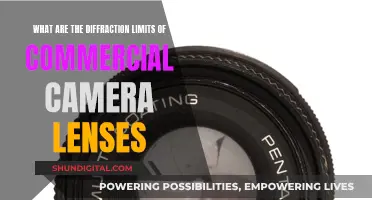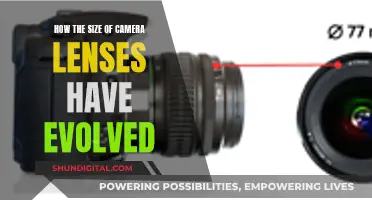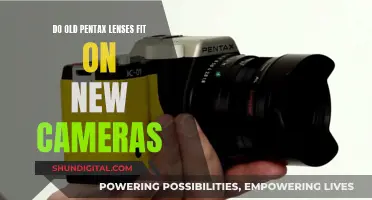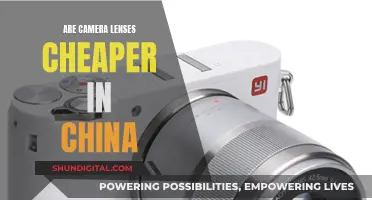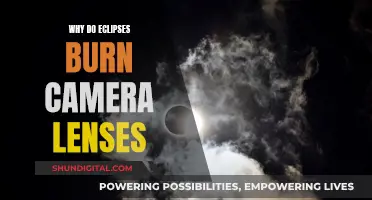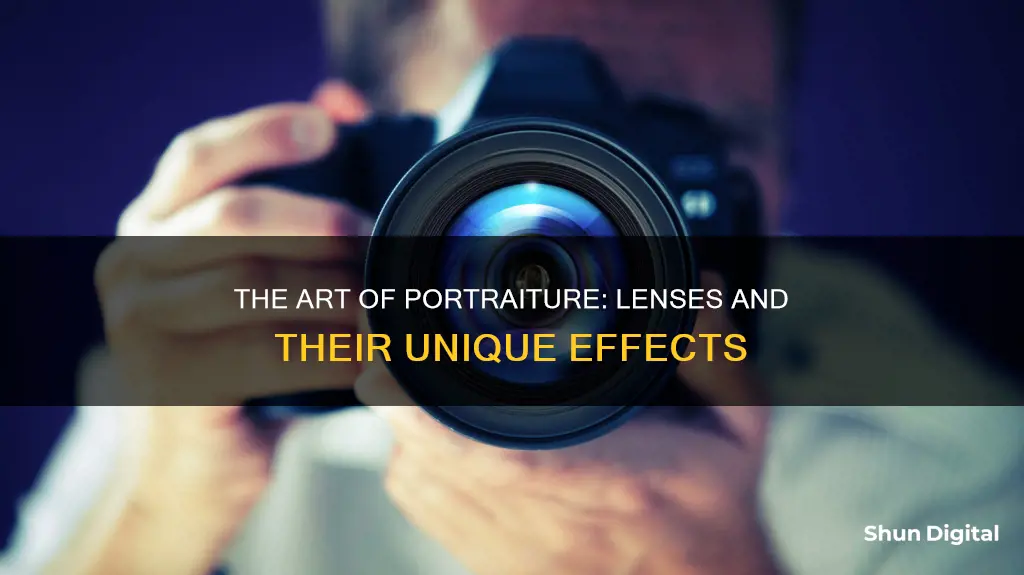
The choice of camera lens can drastically alter the appearance of a person's face in a photograph. Lenses with smaller focal lengths distort the face, making it look thinner, while those over 50mm make it appear more realistic and wider. The distance between the camera and the subject also plays a significant role in the level of distortion, with closer distances leading to more pronounced distortion. The combination of lens focal length and distance from the subject can result in a slimming effect, making it a popular choice for portrait photography.
| Characteristics | Values |
|---|---|
| Lenses with smaller focal lengths | Distort the face so it looks thinner |
| Lenses with larger focal lengths | Make the face look more realistic and wider |
| Lenses with a focal length of 50mm | Look the most "true to life" |
What You'll Learn
- Lenses with smaller focal lengths distort the face so it looks thinner
- Lenses over 50mm make portraits more realistic and wider
- The closer the camera is to the subject, the more substantial the distance between their features
- Shooting from far away with a telephoto lens tends to flatten subjects and make them look heavier
- The human eye sees things differently than a camera lens

Lenses with smaller focal lengths distort the face so it looks thinner
Lenses with smaller focal lengths distort the face, making it look thinner. This is because the shorter the focal length, the closer the camera needs to be to the subject. The closer the camera is to the subject, the more distorted the features become. For example, if the camera is very close to the subject, the nose will be very close to the lens, and the shoulders will be three to four times farther away from the lens than the nose. This will make the nose look much larger in proportion to the rest of the face.
The distortion is caused by perspective distortion, which occurs when the subject is too close to the camera. This is a phenomenon that happens due to the distance between the subject and the camera, rather than the focal length of the lens. If the camera is moved further away from the subject, there will be a lot less face distortion.
The effect of the lens's focal length on the distortion of the subject is indirect. A wider lens requires the photographer to get closer to the subject to keep the same framing. Therefore, it is the changed distance that causes the distortion, not the focal length of the lens itself.
The distortion caused by lenses with smaller focal lengths can be seen in a GIF created by photographer Dunja Djudjic, which shows how the change of focal length affects the face of the person being photographed. The GIF shows the face appearing long and thin when shot with a lens at the lowest end of the focal length range. As the focal length increases, the face becomes larger and rounder.
It is worth noting that the distortion caused by lenses with smaller focal lengths is not always considered a negative effect. For example, when photographing people who are self-conscious about their weight, a lens with a shorter focal length can be advantageous as it forces the photographer to get closer to the subject, causing the body parts to overlap more, resulting in more flattering curves.
The Ultimate Camera Lenses for Professional Photography
You may want to see also

Lenses over 50mm make portraits more realistic and wider
Lenses over 50mm can make portraits more realistic and wider. This is because they can reduce the distortion that is often seen in portraits taken with wide-angle lenses.
When it comes to portrait photography, the choice of lens can have a significant impact on the final image. While wider lenses can make a subject's face appear thinner, lenses over 50mm tend to provide a more realistic representation. This is due to the fact that wider lenses can exaggerate certain features, such as the nose, and make the sides of the face appear narrower. By using a lens with a focal length over 50mm, photographers can capture portraits that more accurately represent the subject's face shape and size.
It is worth noting that the distance between the camera and the subject also plays a crucial role in the amount of distortion present in a portrait. Moving closer to the subject with a wide-angle lens can further exaggerate the distortion, while stepping back and using a longer lens can help to reduce it.
Additionally, lenses over 50mm can also provide a wider field of view, allowing photographers to capture more of the surrounding environment in their portraits. This can be particularly useful when shooting in tight locations or when trying to include more context in the image.
The use of longer lenses, such as those over 50mm, can also create a sense of intimacy in portraits. By allowing photographers to maintain a closer physical working distance to the subject, these lenses can help create a calming environment for the subject, making them feel more comfortable and at ease.
In conclusion, lenses over 50mm can be a great choice for portrait photography as they provide a more realistic representation of the subject's face and offer a wider field of view. They also enable photographers to work within a closer physical distance to the subject, fostering a more intimate and relaxed atmosphere during the photoshoot.
How Camera Lenses Use Refraction to Capture Images
You may want to see also

The closer the camera is to the subject, the more substantial the distance between their features
The distance between the camera and the subject has a significant impact on the final portrait image. This is due to the perspective created by the distance between the subject and the lens. Perspective, in this case, refers to how the distance affects the way the subject's features relate to each other in the image. The closer the camera is to the subject, the more substantial the distance between their features. This is because features that are closer to the lens will appear larger than those that are further away.
This effect can be seen in a viral video by photographer @Harrison, who took selfies using lenses ranging from 16mm to 200mm. The video shows that when shot with a 16mm lens, the subject's face appears long and thin, while with a 200mm lens, the face looks wider and rounder. This is because the photographer had to be much closer to the subject when using the 16mm lens compared to the 200mm lens.
The same effect can be achieved by moving the camera closer or further away from the subject, without changing the lens. This is known as the "dolly zoom" effect. It involves zooming in on the subject while physically moving the camera away from them, or vice versa. This technique can be used to create a sense of tension or vertigo in the viewer.
The distortion caused by the lens or camera position can be minimised by using a 50mm lens on a full-frame DSLR sensor, as this setup is considered to look the most "true to life". However, some photographers prefer to use longer focal lengths for portraits as they can create a more flattering image by making the subject's face appear slimmer.
Lens and Camera Compatibility: Are Lenses Camera-Specific?
You may want to see also

Shooting from far away with a telephoto lens tends to flatten subjects and make them look heavier
Shooting portraits from far away with a telephoto lens can have a range of effects on the final image. A telephoto lens is considered to be a ""medium telephoto" when its focal length is greater than 70mm, and a ""full telephoto" when its focal length is greater than 135mm. These lenses are typically used to capture subjects from a distance, and they can have a significant impact on the way that the subject is portrayed.
One of the key effects of shooting with a telephoto lens is the normalization of relative size between near and far objects. This means that objects that are closer to the camera will appear similar in size to objects that are farther away, even though they may appear larger in person. This can be used to give a proper sense of scale in an image, but it can also make the scene appear static, flat, and uninteresting, as the viewer's eyes generally expect closer objects to be larger.
Additionally, telephoto lenses can make the distance between objects appear compressed, which can be beneficial when trying to emphasize the number of objects or enhance the appearance of congestion. This effect can be advantageous in certain types of photography, such as wildlife or landscape photography, where you want to capture multiple elements in a scene without making it seem too sparse or distant.
Another important consideration when using telephoto lenses is the impact on the depth of field. While a telephoto lens itself does not inherently decrease the depth of field, the way it is typically used does. Photographers often magnify their subjects more with telephoto lenses, and as a result, the background appears more out of focus, creating a shallower depth of field. This can be advantageous for isolating the subject and making them the main point of focus, but it requires precise focus to ensure that the critical areas of the image, such as the
Furthermore, shooting with a telephoto lens from a distance can affect the perspective of the image. The use of a telephoto lens may mean that you are farther from your subject, which can alter the perspective and make the subject appear flatter and wider than they would with a shorter focal length lens. This effect is especially noticeable when comparing images taken with a wide-angle lens, where the subject's face may appear distorted and thinner.
To summarize, shooting portraits from a distance with a telephoto lens can result in a normalization of relative sizes, compression of distances, a shallower depth of field, and a change in perspective that can make subjects appear flatter and wider. These effects can be advantageous in certain types of photography, but it is important to consider the potential impact on the final image to ensure the desired result.
Lending Camera Lenses: A Unique Library Offering
You may want to see also

The human eye sees things differently than a camera lens
The human eye has a focal length of around 22mm, but this is misleading due to the curve of the eye, the decreasing detail in our peripheral vision, and the fact that we see with two eyes. Each eye has a 120-200° angle of view, but our extreme peripheral vision is only useful for sensing motion and large-scale objects. Our central angle of view, around 40-60°, is what most impacts our perception. This is similar to a 50mm "normal" focal length lens on a full-frame camera.
The lenses in our eyes change shape to stay focused on a moving object, and the thickness of the lens changes depending on the image being viewed. This is possible because the lens is attached to small muscles that contract and relax. A camera lens, on the other hand, cannot do this, which is why photographers change lenses depending on how far away they are from an object.
In low-light conditions, our eyes are less sensitive to colour than normal, whereas camera sensors always have the same sensitivity. This is why photographs taken in low light appear to have more colour than we remember. Our eyes also see in monochrome in extremely low light, such as under moonlight or starlight.
Our eyes also have a blind spot where the optic nerve connects to the retina, whereas a camera lens sees a "full" picture.
Verizon Wireless Stores: Do They Sell Camera Lenses?
You may want to see also
Frequently asked questions
There is no definitive answer to this question as different lenses will produce different effects. However, lenses with smaller focal lengths distort the face, making it look thinner, while those over 50mm make it more realistic and wider.
Lenses with smaller focal lengths distort the face so that it looks thinner. This is because the photographer has to be closer to the subject, which makes the nose look bigger relative to the rest of the face. Lenses with longer focal lengths make the face look wider and more realistic as the photographer has to be further away, reducing the distortion.
Wide-angle lenses have a smaller focal length, which means the photographer has to be closer to the subject. This can make the subject's face look distorted, with certain features appearing unnaturally large. Telephoto lenses have a longer focal length, allowing the photographer to capture the subject from further away, which can result in a more realistic and flattering image.


